Scroll to:
SMART METERING SYSTEMS: АN EMPIRICAL ANALYSIS OF TECHNOLOGY PERCEPTION FACTORS
https://doi.org/10.17747/2618-947X-2021-1-8-23
Abstract
The use of smart metering systems for electricity is one of the key components of the digital transition in the power industry. Smart metering systems are equipped with modules for collecting, processing, storing, sending and receiving data, and their implementation generates a wide range of effects for electricity companies, electricity consumers, as well as authorities and industry regulators. The functionality of smart metering systems can be significantly expanded when using non-intrusive load monitoring meters.
The purpose of this work is to develop a list of factors that have both a positive and a negative impact on the perception of intelligent metering systems technologies both among power companies and end consumers - participants in retail electricity markets.
At the first stage of the study, based on the models of E. Rogers and F. Davis, a list of factors influencing the adoption of smart metering technologies by both energy companies and end consumers of electricity was developed. Based on in-depth interviews with experts, the factors were verified and questionnaires were developed for the next stage of the study.
At the second stage, a quantitative study was carried out, which made it possible to determine the degree of influence of factors on the adoption of smart metering technology by users.
At the end of the work, recommendations were developed to accelerate the distribution of smart metering systems and quickly achieve positive effects from their implementation.
For citations:
Kuzmin P.S. SMART METERING SYSTEMS: АN EMPIRICAL ANALYSIS OF TECHNOLOGY PERCEPTION FACTORS. Strategic decisions and risk management. 2021;12(1):8-23. https://doi.org/10.17747/2618-947X-2021-1-8-23
1. INTRODUCTION
The fourth industrial revolution, characterized by the interaction of digital, physical and biological domains [Schwab, 2016], is fundamentally transforming the face of the electric power industry both around the world and in Russia. The introduction of technological innovations, in addition to increasing efficiency and effectiveness of companies, leads to a significant change in technical and economic paradigms, market environment, as well as business and organizational models of companies [Freeman et al., 1982; Technical change .., 1987].
Researchers have shown that one of the main technologies for the digital transition in the electric power industry is the technology of intelligent electricity metering systems (IMS)[Khovalova, Zholnerchik, 2018; Smart grids ..., 2013]. Such systems are based on electricity meters equipped with modules for collecting, processing, storing, sending and receiving data.
Unlike traditional electricity meters, smart metering systems have a wider range of functions:
- monitoring of consumption in real time;
- the ability to aggregate data from various counters into a single database;
- storage of statistical data on electrical characteristics;
- obtaining information on power flows and reliable determination of the level of technological and commercial losses in power grids;
- identification of unaccounted energy consumption and the facts of impact on meters;
- formation of energy saving strategies and assessment of their implementation;
- remote power consumption limitation.
However, despite the current extensive functionality of intelligent accounting systems, IMSs built on the basis of Non-Intrusive Load Monitoring (NILM) technology have even greater capabilities. NILM is a method for analyzing total electrical load data obtained by measuring current and voltage at one point, with the subsequent division of the total load into the loads of individual devices [Kuzmin, 2019].
The researchers note that non-intrusive load monitoring technology can play a key role in the digital transition in the power industry [Zoha et al., 2012]. It cannot only improve the current operating activities of power companies, but also form the basis for the formation of new relations between the subjects of energy markets [Bergman et al., 2011; Lin, Wang, 2016; Zhuang et al., 2018].
IMS based on non-intrusive load monitoring have two significant differences that determine the specificity of their application:
- non-intrusiveness - the meter of such an IMS measures the current and voltage in one place of the power distribution network of the building and does not require direct integration into the network, while ensuring the measurement accuracy, which is not inferior to traditional meters (including those equipped with Wi-Fi and GSM-modules);
- data disaggregation - at the moment, if it is necessary to allocate energy consumption profiles for each device located in the room, a direct connection meter is installed at the entrance to each device. The NILM meter, using cloud technology and special machine learning methods, breaks down the integral energy consumption data collected at one point in the network into consumption profiles for each device. Since the cost of installing direct connection meters is directly proportional to their number, the use of NILM sensors contributes to significant savings [Naghibi, Deilami, 2014]. This effect is even more pronounced when equipping large commercial real estate with meters, as well as in industries using a large number of equipment.
Based on their technological features, IMS, using nonintrusive load monitoring meters, are able to find application in many areas:
- disaggregation of total energy consumption and visualization. With the help of NILM sensors, consumers are able to allocate the energy consumption of each device. The result of disaggregation in the form of interactive infographics is displayed in a mobile application or in a customized online platform. The amount of useful data can be significantly increased by installing several sensors (for example, you can divide energy consumption between floors in a multi-storey building or collect information on the utilization of production equipment in various rooms of a large enterprise);
- identification of non-standard operating modes of devices and preventive monitoring of breakdowns. Since the sensors collect data in real time, the system remembers the patterns of the devices' behavior. Using the methods of neural network analysis, the system recognizes changes in the operating mode of the device and promptly sends a notification to the user about the detected violation;
- splitting the bill for the purchase of electricity. Using the device-by-device split of energy consumption, you can split the invoice accordingly. With a differentiated cost of electricity by zones of the day, you can generate a report on the costs of operating the device in a given period of time. Thus, it becomes possible to optimize the operating mode of devices, develop a schedule for optimal energy consumption and reduce the cost of purchasing electricity;
- embeddability into third-party solutions. On-device load sharing is one of NILM's most important technology features. This solution can be built into traditional metering devices of direct connection;
- sending alerts and notifications. Using a mobile application or a customized online platform, the NILM system is able to send notifications to the user about violations of device operating modes or when userspecified levels are exceeded (for example, if the operating time of the stove exceeds the set or when the specified energy consumption level is exceeded).
A number of researchers conclude that the impact of the digital transformation of the electric power industry, including the impact of the introduction of intelligent metering systems, will become the strongest for end consumers of electricity [Trachuk, 2010; Digital transition .., 2017; Khokhlov et al., 2018], while the most significant changes will be experienced by end consumers in the retail market. The introduction of intelligent electricity metering systems (including those based on NILM technology) generates a wide range of effects both for end consumers and for companies in the electric power industry [Trachuk, 2010; Kuzmin, 2019]. Comparison of the effects created by the IMS with the participants in the electricity and capacity market is presented in table. 1.
Table 1
Comparison of the effects created by the IMS with the participants of the electricity and capacity market
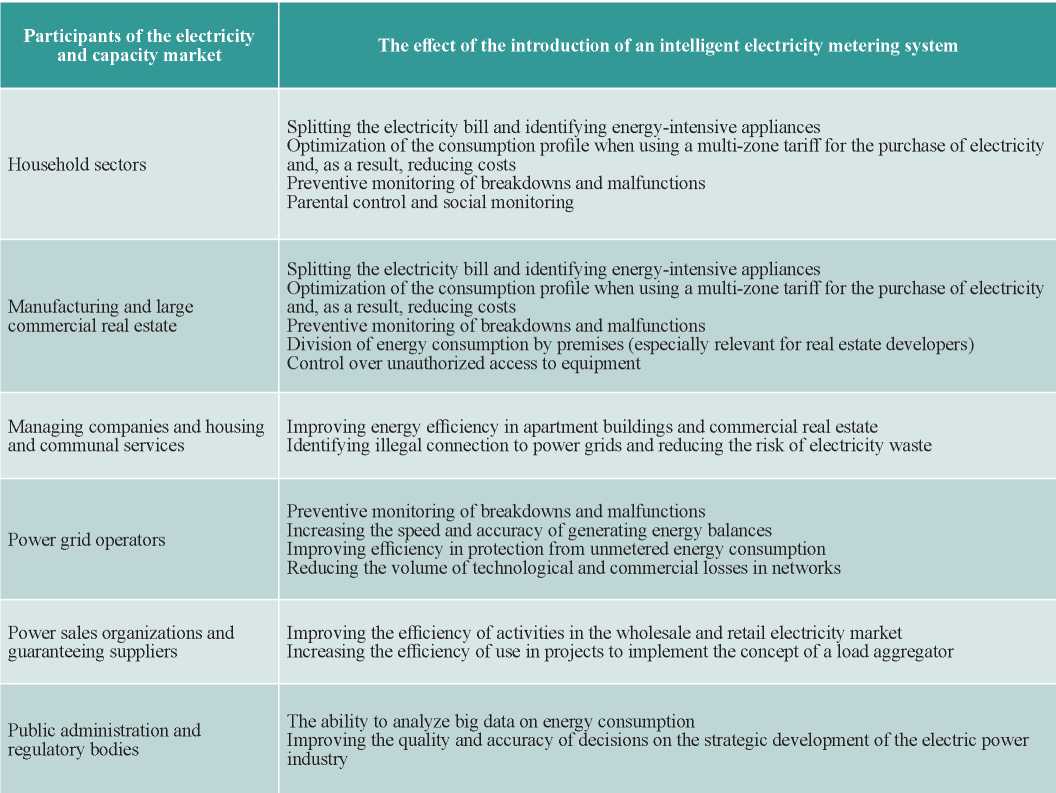
Source: составлено автором.
A large number of works have been devoted to the topic of implementing smart metering systems. However, they are mainly scientific and technical publications, the focus of which is on the technological aspects of the creation and implementation of intelligent electricity metering systems, articles exploring the positive effects of implementation and the possibility of commercializing data collected using the IMS [Devlin, Hayes, 2018; McKenna et al., 2012]. Other researchers have assessed the applicability of the IMS in the implementation of demand management and active consumer models [Bergman et al., 2011; Lin, Wang, 2016; Zhuang et al., 2018]. However, among scientific works there are not enough publications that investigate the nature of the perception of IMS technologies by potential users, which directly affects the speed of technology spread.
Thus, the task of this work is to identify and systematize factors that have both a positive and a negative impact on the perception of smart metering systems both among electric power companies and among end consumers - participants in the retail electricity markets.
2. THEORETICAL BASIS OF ANALYSIS OF INNOVATION ACCEPTANCE
The adoption of innovative technologies by industrial companies is considered by a small number of studies. The most widespread models of factors of adoption of innovations are described in the works [Molla, Licker, 2002; 2005]:
- POER model - for the study of intra-organizational factors that influence the perception of innovation. This model is designed to assess the factors of the intra-organizational environment: how employees perceive innovative technologies, whether they tend to accept them, how they assess risks and difficulties during implementation;
- PEER model - for assessing environmental factors, namely the pressure of other market players, regulatory bodies, as well as technological changes in the industry.
On the part of end consumers, the following methods of analyzing consumer acceptance of innovative technologies are most often used:
- process approach. This approach is aimed at analyzing the process of accepting an innovation - an independent process that shows how an individual, through several stages, develops an attitude towards an innovation, accepting or rejecting it.
- factorial approach. Based on the identification and analysis of factors that have a positive or negative impact on the perception of innovative technology by the consumer.
The process approach considers the adoption of an innovation as a series of successive stages replacing each other. Some of the most popular models for describing innovation adoption are Everett Rogers’ innovation diffusion model [Rogers, 2003] and Frank Davis's technology acceptance model [Davis, 1989].
Diffusion of innovations is described by Rogers as a combination of key components: innovation, person, time, communication channels and the social system, as well as a series of stages of adoption of an innovative technology: awareness, interest, evaluation, testing, adoption of technology (adoption) (Fig. 1).

Rice. 1. The process of consumer acceptance of innovative technology
Source: [Rogers, 2003].
First, the consumer receives initial information about the technology, then, based on this information, forms his attitude towards it. If the innovation interests the consumer, he assesses its applicability and, if a positive decision is made, proceeds to the stage of testing the innovation, defining its advantages and disadvantages for himself. The final stage is the acceptance stage. In the case of a positive assessment of the technology, a person makes a decision on its further use, and if it is negative, he refuses to accept it.
An important provision in Rogers' model is the segmentation of potential consumers based on individual predisposition to the adoption of innovative technologies:
1) innovators (2.5%): risk-oriented, inclined to accept innovations in the forefront, are able to absorb complex technical knowledge, have sufficient financial resources to compensate for risks;
2) early adopters (13.5%): make up the bulk of “opinion leaders”, it is them that relatively late followers are guided by;
3) early majority (34%): representatives of this segment may show some uncertainty before the adoption of the innovation, in the process of adopting the innovation they prefer to follow the early adopters;
4) late majority (34%): a skeptical group of consumers, their acceptance of innovations occurs either under increasing social pressure or due to economic necessity;
5) latecomers (laggards, 16%): consumers of a conservative orientation, accept an innovation only when it is fully integrated into the environment, and may refuse to accept it altogether.
Davis's model of technological acceptance (Fig. 2) was created to describe the factors involved in the activities of the employees of a computer equipment enterprise in the workplace and was based on the assumption that the use of a particular technological innovation depends on the attitude formed by a person towards it, as well as the ability and intention to use it. Later, the model was successfully used to study the innovative activities of companies [Rebyazina et al., 2011], as well as the spread of distributed generation [Trachuk, Linder, 2018].
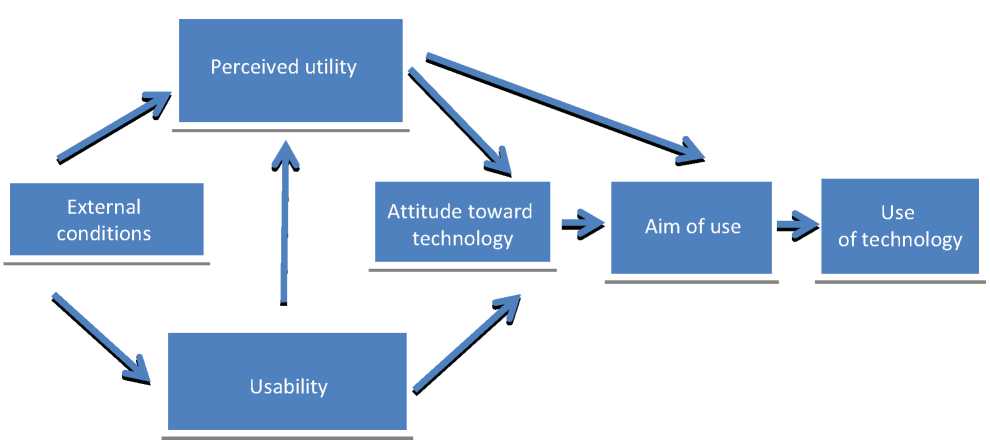
Fig. 2. The Davis Model of Technological Adoption
Source: [Davis, 1989].
The factorial approach is based on the analysis of the factors that have the greatest influence on the consumer's decision to adopt an innovation.
Rogers and Davis identified two groups of factors that influence the perception of technology: general and specific. Common characteristics of innovation were identified by Rogers and include compatibility, testability, comparative advantage, and acceptability. Davis formulated the specific characteristics of innovation: speed, reliability, pleasure in use, control of the process of use, perceived risks of use.
Table 2 presents general and specific characteristics that influence the adoption of innovations.
Table 2
General and specific characteristics infl uencing the adoption of innovations
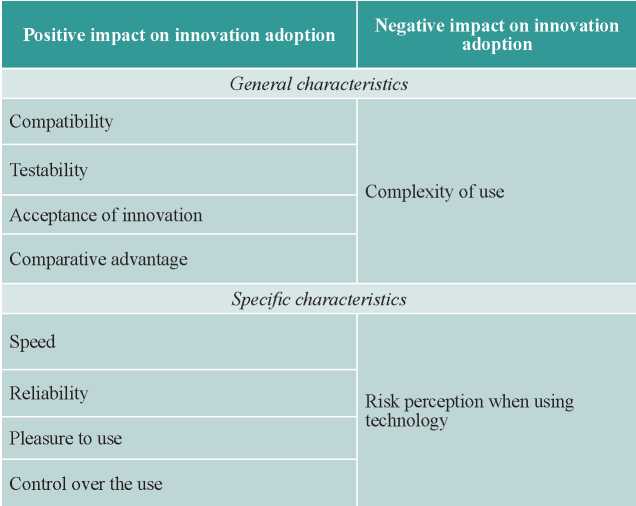
Source: compiled by the author.
Adoption of intelligent electricity metering systems technology. For further research, it is necessary to identify the factors influencing the adoption of IMS technology within the companies in the electric power industry.
Table 3 collected intra-organizational factors and environmental factors that were identified in the relevant studies.
Table 3
Factors influencing the adoption of smart metering technology
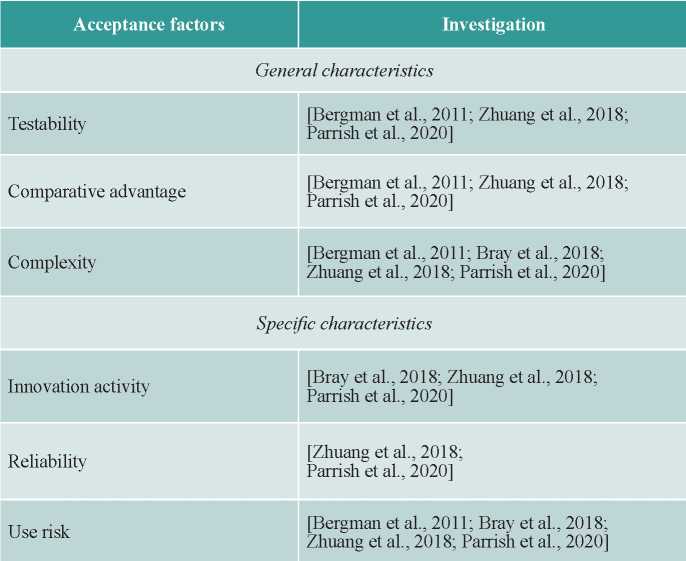
Source: compiled by the author
After the analysis of innovative technologies adoption models on the part of industrial companies and on the part of end users, a number of the most significant factors were identified that form the user's decision to adopt a technology.
After identifying the factors in the adoption of IMS technologies, it is necessary to proceed to the formation of a sample and conduct a study in order to obtain a quantitative assessment of the nature and degree of influence of the factors.
3. QUALITATIVE STAGE OF THE RESEARCH
To study the previously identified factors in the adoption of IMS technologies, a qualitative stage of analysis was carried out in order to verify the factors affecting the adoption of smart metering technologies, and to develop a detailed questionnaire for subsequent quantitative analysis.
Table 4
Factors Affecting the Adoption of Smart Metering Systems Technologies by Electricity Companies
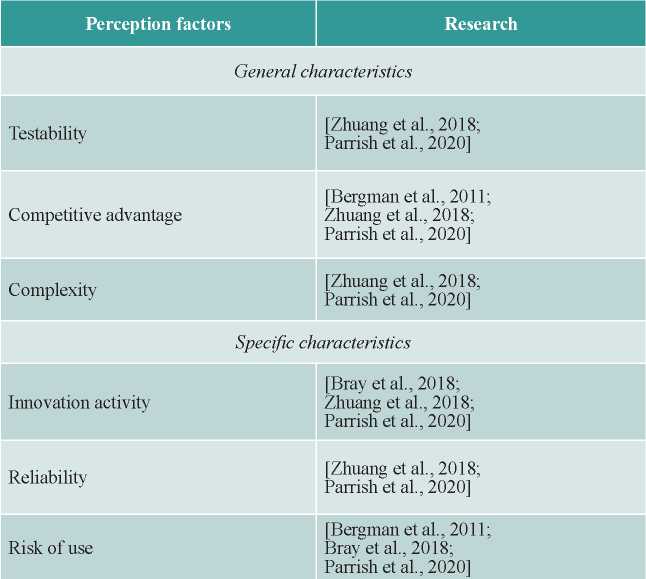
Source: compiled by the author
The qualitative stage consists of in-depth semi-structured interviews with eleven representatives of power companies, as well as companies - consumers of electricity in the retail markets.
Employees of electric power companies, such as retail, power grid and generating companies, companies of the commercial infrastructure of the wholesale electricity and capacity market were selected for the interview. The consumer side was represented by employers from large construction companies, owners of commercial real estate, retail trade, as well as a Russian company engaged in the research, development and production in the field of state emblems.
Each of the respondents holds a managerial position at the level of deputy director of the department and above and:
- has a scientific interest in digital technologies in the electric power industry;
- has an idea or knows examples of using smart metering systems;
- potentially interested in testing smart metering systems;
- is directly related to the field of innovative development in the electric power industry.
The author also managed to conduct an interview with the founder of a company that manufactures and supplies non-intrusive load monitoring systems in the European Union.
Based on the results of the analysis of the interviews, the factors influencing the adoption of technologies of intelligent energy metering systems were confirmed and updated both among energy companies (Table 5) and among end consumers in the retail markets (Table 6).
Table 5
Factors Affecting the Adoption of Smart Metering Systems Technologies by Electricity Companies
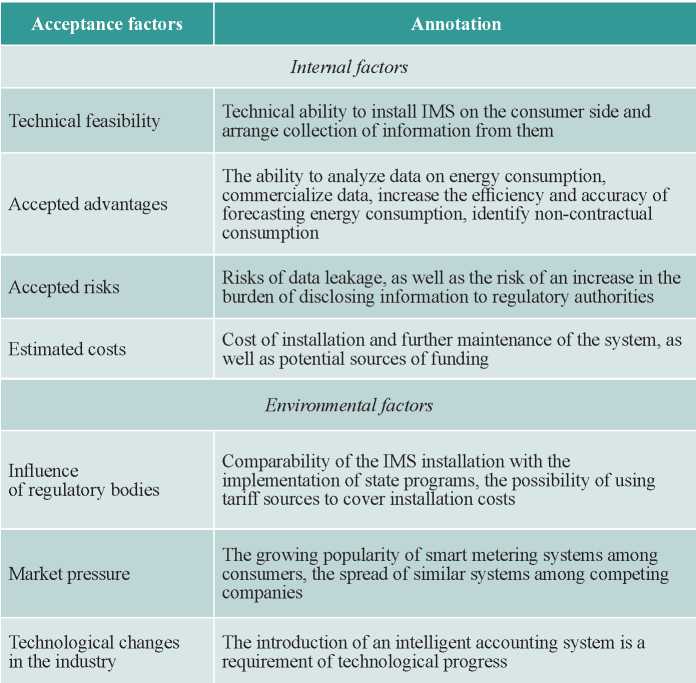
Source: compiled by the author
Table 6
Factors Affecting the Adoption of Smart Metering Systems Technologies by Electricity Companies
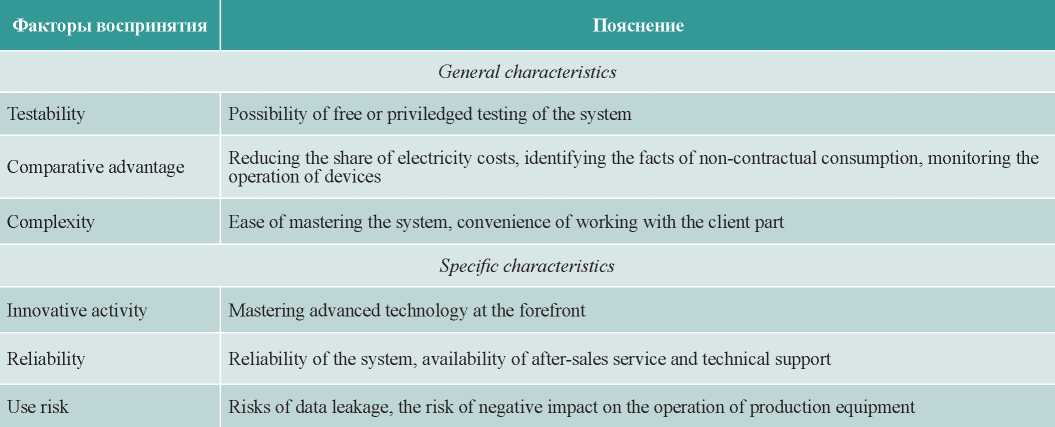
Source: compiled by the author
The next step is to calculate Spearman's nonparametric correlation coefficients (ρS) for ranked data to confirm relationships between model elements. The relationships between the components of the model are considered significant if the correlation coefficient exceeds the threshold value of 0.50.
In the course of the correlation analysis, it was found that the adoption of smart metering technologies by electricity companies is associated with technical feasibility (ρS= 0,76), perceived risks (ρS= 0,57), perceived benefits (ρS= 0,80), expected costs (ρS= 0,61), the influence of regulators (ρS= 0,53), pressure of the market environment (ρS= 0,81), technological changes in the industry (ρS= 0,52).
The results of the analysis of interviews conducted with representatives of companies in the electric power industry confirm the selected factors of the internal and external environment, as well as their interconnection, and serve as an additional justification for the questionnaire developed to quantify the factors influencing the adoption of IMS technologies.
Correlation analysis of general and specific factors for end consumers of electricity in retail markets revealed the connection between decision making on use with testing capability (ρS= 0,54), comparative advantage (ρS= 0,68),complexity of development (ρS= 0,52), innovative activity (ρS= 0,62), reliability (ρS= 0,60), risk of use (ρS= 0,64).
The results of the analysis of interviews conducted with representatives of companies - end consumers of electricity, confirm the selected general and specific factors, as well as their interconnection, and serve as an additional justification for the questionnaire developed to quantify the factors influencing the adoption of intelligent metering systems.
4. QUANTITATIVE STAGE OF THE RESEARCH
After substantiating the factors of adoption of technologies for intelligent electricity metering systems questionnaires were drawn up as well as a survey was conducted among representatives of electric power companies and end consumers of electricity (162 respondents, Table 7). The aim was to further build a regression analysis model designed to determine the degree of influence of the identified factors on the decision to implement IMS. To measure the identified factors, the statements of the questionnaire were formulated, the respondents were asked to choose the degree of agreement with them. To measure the degree of agreement, a seven-point Likert scale was used, where 1 - "completely disagree", 4 - "I do not know whether I agree or disagree", 7 - "completely agree". The survey questions are given in table 8, 9.
Table 7
Sample structure on company profile
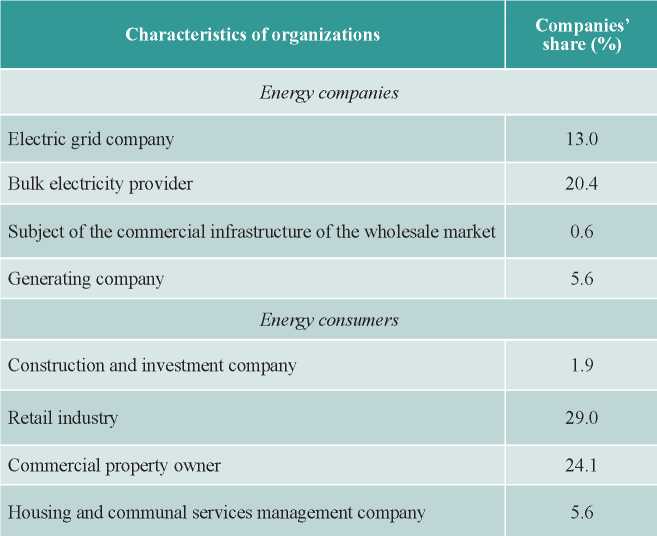
Source: compiled by the author
Table 8
Indicators for measuring the factors of adoption of technologies of intelligent metering systems by electric power companies
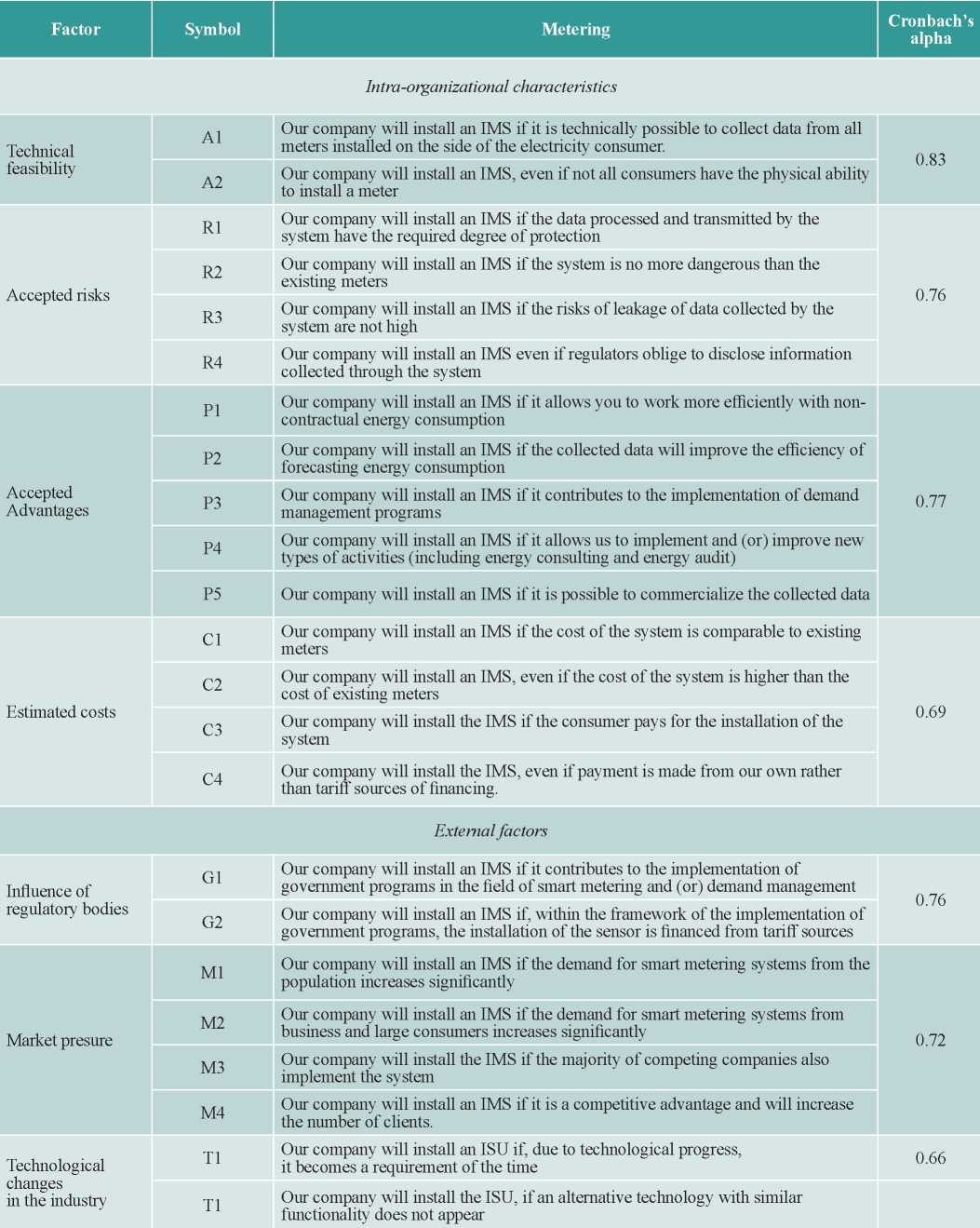
Source: compiled by the author
Table 9
Indicators for measuring the adoption factors of intelligent accounting systems technologies by end users
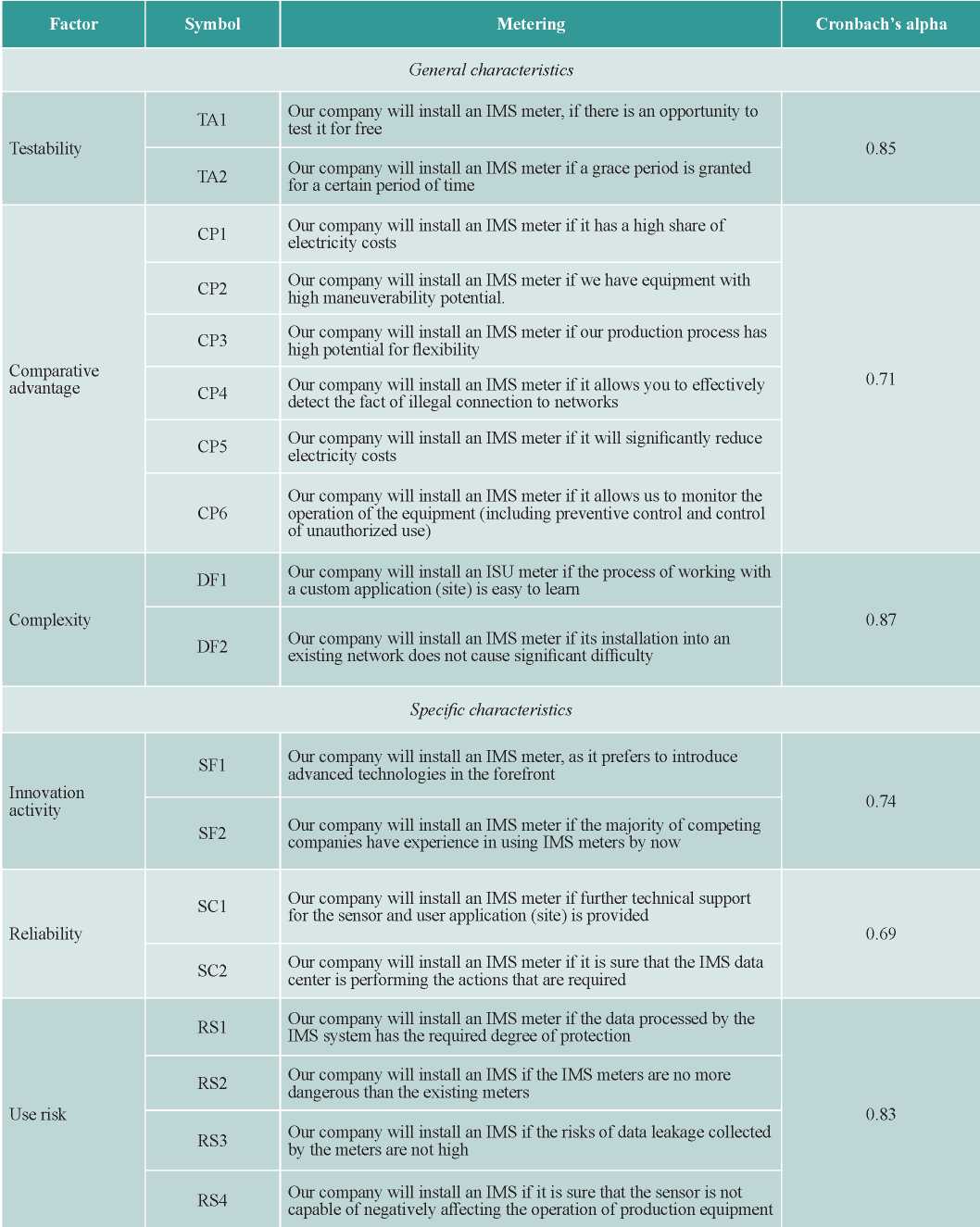
Source: compiled by the author
To measure the factor "Technical Feasibility", a scale with two questions was used to assess how the company's ability to collect data from consumers affects decision-making.
To assess the Perceived Risks factor, we used a scale with four questions, assessing the risks of data breaches and their consequences, as well as the risk of an increase in the amount of information disclosed at the request of regulatory authorities. The Perceived Benefit factor was measured using five questions describing a range of improvements to the company's current operations, as well as new sources of revenue. The “Expected Costs” factor was measured by four questions describing the costs of installing the IMS, as well as the sources of covering the costs. To measure the factor “Influence of regulatory bodies”, two questions were used that described the compliance of the IMS installation with government programs and the possibility of including costs in tariff sources. “Market pressure” was assessed using four questions focused on interest in smart metering technology from end users as well as competitors. The factor "Technological changes in the industry" was measured by two questions characterizing the need to implement IMS technologies if it becomes a time requirement or technologies with similar functionality develop.
Similarly, questions were formed to study general and specific factors affecting the adoption of IMS technologies by end users in the retail electricity markets. Testing ability was measured by two questions assessing respondents' attitudes toward the ability to test MIS for free or with a grace period. Comparative advantage was measured as an assessment of how significant the positive effects of the introduction of an IMS on end users are. Difficulty in mastering was measured with the help of two questions assessing how ready the respondents are to master the new technology. The factor "Innovative activity" was measured in accordance with the questions regarding the importance for the respondent to be an innovator. The Reliability factor was measured in accordance with the respondents' assessment of the need for after-sales service and technical support. To assess the Perceived Risks factor, a scale with four questions was used, assessing the risks of data breaches and their consequences, as well as the risk of a negative impact of the IMS on the operation of production equipment.
At the beginning of the quantitative analysis, reliability factors (Cronbach's alpha) were calculated for all factors studied on the basis of multi-question scales. The obtained coefficients satisfy the requirement for the minimum level of reliability for field research - 0.65. Further, factor analysis was performed using the principal component method and orthogonal rotation that maximizes variation (varimax) for four groups of questions describing four aspects of intraorganizational factors, and three groups of questions describing three aspects of external factors.
Factor analysis based on the method of principal components with orthogonal rotation, which maximizes variation, revealed the presence of four intraorganizational characteristics and three environmental factors, which described a total of 87.2% of the variation in questions. The values of the obtained factors were used to form the final set of factors that influence the adoption of smart metering technologies by electric utilities and which were then included in the regression analysis model.
The results obtained at the end of the factorial analysis were used to determine the degree of influence of factors on the adoption of technologies of intelligent metering systems among energy companies:
Yi= β0+ β1 ·Ai+ β2 ·Ri+ β3 + Pi+ β4· Ci+ β5· Gi+ β6· Mi+ β7· Ti+ εi, (1)
Where Yi – is the indicator of the adoption of the technology of intelligent metering systems (binary variable, where 1 is the technology of intelligent metering systems for electricity adopted for use by the company; 0 - not accepted); Ai - the possibility of technical feasibility for using the IMS; Ri– risks perceived by companies associated with the use of IMS; Pi – the perceived advantages of using the IMS by the company; Ci– the expected costs of the installation of the IMS; Gi – pressure from the regulating bodies, affecting the installation of the IMS; Mi – market pressures affecting the adoption of smart metering technologies; Ti – technological changes in the industry, contributing to the adoption of smart energy metering technologies; εi – random error.
The study of general and specific factors influencing the adoption of smart energy metering technologies by end users in the retail electricity markets was carried out by means of eighteen questions.
Overall, three general and three specific factors explained 81.3% of the variation in answers to questions by respondents, which is in line with the recommendations to explain 70% of the variation in structural models.
The study of general and specific factors in the adoption of technologies of intelligent metering systems by end consumers of electricity was carried out according to the following model:
Yi= β0+ β1 ·TAi+ β2 ·CPi+ β3 ·DFi+ β4· SFi+ β5· SCi+ β6· RSi+ εi, (2)
where Yi – is the indicator of adoption of smart metering technologies (binary variable, where 1 - smart metering technology is adopted for use by the company; 0 - not accepted); TAi – the ability to test the IMS; CPi – the comparative advantage associated with the use of IMS; DFi– the complexity of mastering the use of IMS; SFi – innovative activity of consumers, influencing the decision to install the IMS; SCi – reliability of using the IMS; RSi – risks of use, affecting the adoption of technologies of intelligent accounting systems; εi – random error.
With the use of the maximum likelihood method, standardized and non-standardized regression coefficients were obtained, which were subsequently used to determine the degree of influence of factors on the adoption of intelligent accounting systems.
Regression analysis made it possible to identify the degree of influence of various factors on the adoption of smart metering technologies by companies in the electric power industry (internal organizational characteristics of the company and environmental factors), as well as the degree of influence of general and specific factors (Tables 10-11). The impact of these independent variables on the adoption of IMS was assessed via the maximum likelihood method.
Table 10
Acceptance of IMS technologies: the infl uence of intra-organizational factors and environmental factors
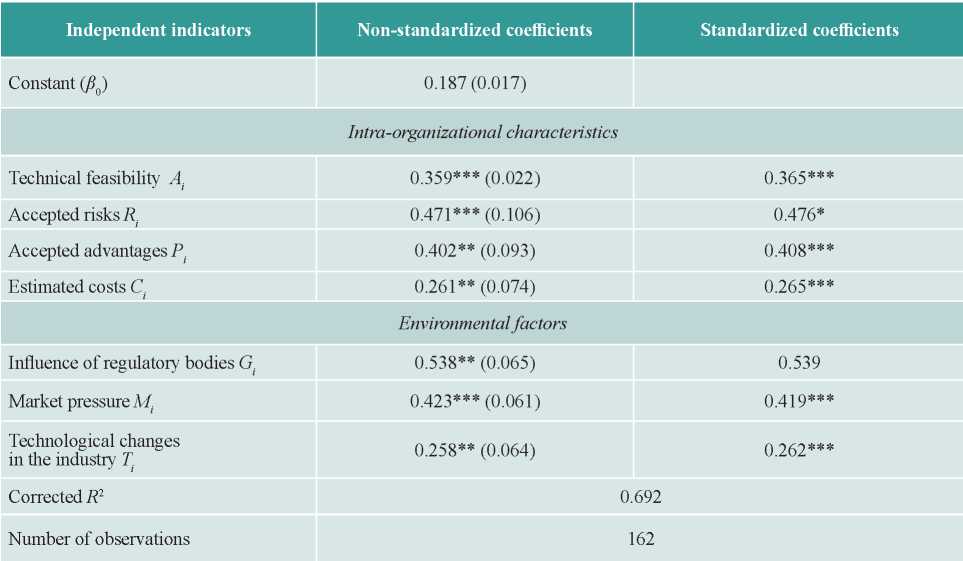
Note. * – p < 0.10; ** – p < 0.05; *** – p < 0.01. Standard errors are given in parentheses.
Source: compiled by the author.
Table 11
Acceptance of IMS technologies: infl uence of general and specifi c factors
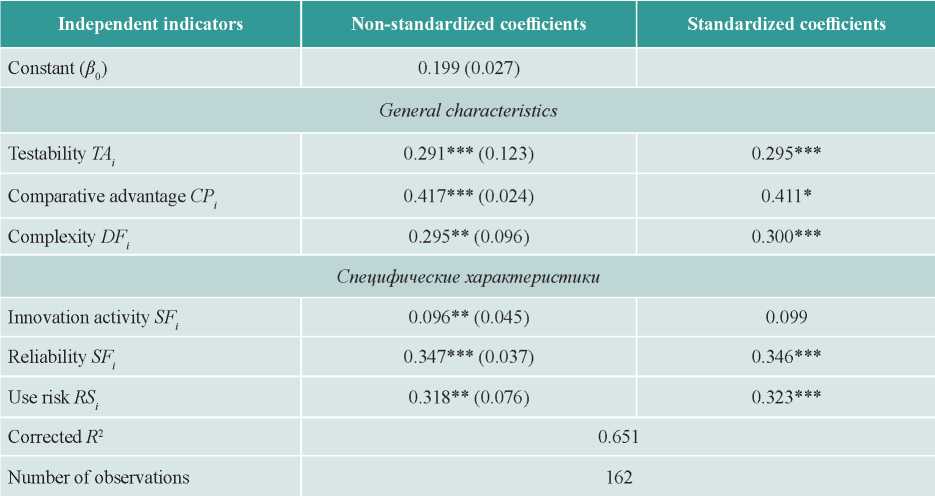
Note. * – p < 0.10; ** – p < 0.05; *** – p < 0.01. Standard errors are given in parentheses.
Source: compiled by the author.
Interpretation of the data obtained allows us to answer the first research question: "What factors influence the adoption of technologies for intelligent electricity metering systems, what is the degree of their influence?"
Table 10 shows the results of regression analysis of the influence of intra-organizational factors and environmental factors on the process of adopting technologies of intelligent accounting systems. All characteristics have a positive effect on the adoption of technology, but the degree of their influence is different, due to the specifics of the compiled questionnaire. The obtained regression coefficients can be used to compare the degree of significance of factors influencing the adoption of IMS by electric utilities.
Thus, when deciding on the implementation of the IMS, the most powerful influence is exerted by the pressure of the regulatory bodies (β = 0,538), as well as the low level of risk of using the technology (β = 0,471). The factor associated with the risk of data leakage is no less important: the IMS should be no more dangerous than the existing metering devices, and the risks of leakage should not lead to serious consequences. Market pressure (β = 0,423) and perceived advantages (β = 0,402). are of no less importance for the companies. The factor related to technical feasibility (β = 0,359), has a moderate impact, which may indicate that the company is ready to implement an IMS, even if it is not possible to collect data from all meters. Factors related to estimated costs (β = 0,261) and technological changes in the industry (β = 0,258) have relatively little influence.
Table 11 shows the results of a regression analysis of the influence of general and specific factors on the process of adopting intelligent metering systems by the end consumer of electricity in the retail markets. All characteristics have a positive effect on the adoption of technology, but the degree of their influence is different, due to the specifics of the compiled questionnaire. Similarly to the analysis of the results for electric power companies, the obtained regression coefficients are used to interpret the impact of factors influencing the adoption of the IMS by consumers in the retail markets.
The perceived comparative advantages (β = 0,417), as well as the low risk level of using the technology (β = 0,318)and its reliability (β = 0,347). influence end users when they make a decision about the implementation of IMS. This may be due to the desire of consumers to use their equipment as efficiently as possible and protect themselves from commercial losses. At the same time, consumers want to be sure that the installed intelligent electricity metering system is not capable of negatively affecting the operating modes of production equipment, and the system itself will be provided with a high level of technical support. Of no less importance is the factor connected with the risks of data leakage: IMS should be no more dangerous than existing metering devices, and the risks of leakage should not lead to serious consequences. The ability to preferentially test the system and see its benefits has a moderate impact (β = 0,291), as well as the difficulty of mastering (β = 0,295). Consumers are ready to start using the system, if its development does not involve significant difficulties, and the system interface is understandable. The factor associated with the company's innovative activities has a low degree of influence. The factor associated with the company's innovative activities has a low degree of influence (β = 0,096). Analyzing indepth interviews, the low degree of the influence of this factor can be explained by the fact that innovation activity is of little interest to the company in isolation from achieving any comparative advantages.
5. CONCLUSIONS AND RECOMMENDATIONS FOR IMPLEMENTATION
The quantitative stage of the study showed the degree of influence of various factors in the adoption of technologies of intelligent electricity metering systems in the context of electric power companies and companies that consume electricity in retail markets. It has been empirically shown that regulatory pressures and the level of use risk are most influential in adopting smart metering by utilities. For consumers, the decisive factors are related to the benefits from the introduction of IMS with low risks of use and a high level of reliability. Most of the respondents identified these aspects as the most important.
At the end of the work, a list of measures will be presented to accelerate the implementation of technologies for intelligent energy metering systems, as well as a number of solutions aimed at further developing of innovative energy practices.
Recommendations for electricity suppliers. The most significant effects from the introduction of technologies of intelligent electricity metering systems will be observed with a wide coverage of end consumers of electricity. Based on this, in the early stages of implementation, it makes sense to centrally install meters in order to provide the first consumers with the opportunity to test and visually study the benefits of the technology. As measures for centralized implementation, you can propose:
- centralized renewal of the electric power metering systems fleet. Energy companies can replace traditional meters with IMS meters (for example, when replacing metering devices that have exhausted their service life) and provide a grace period for testing consumers;
- interaction with investment and construction companies. IMS can be implemented at the stage of construction of a real estate object, for example, a commercial building or a modern residential complex. The advantage of this method is that the cost of installing the meters will be taken into account at the stage of project development.
In addition to being able to test and understand comparative advantage for users (and for utilities), one of the most important factors is data security. To ensure an adequate level of security, it is recommended to implement a processing system on the territory of the Russian Federation and, if possible, avoid cross-border data transmission, as well as use secure transmission technologies. A significant help will be the availability of a developed IT infrastructure in the ownership of the energy company.
An analysis of the factors influencing the adoption of IMS technologies by its consumers showed that the reliability of the IMS operation and a high level of technical support are important to users. Thus, energy companies need to pay attention to the development of interaction with customers, both in terms of the reliability and intuitive clarity of the user application and online platform, and in the context of personal technological support.
Recommendations for demand aggregators
Subjects of the electric power industry, including guaranteeing suppliers and independent power supply companies or electricity consumers who have entered into an agreement for the provision of services to change the load with consumers of the retail electricity market, can qualify the competitive selection conducted by JSC System Operator of the Unified Power System and receive the status of a demand aggregator.
The market for demand management services is quite promising and, according to the estimates of the National Technology Initiative Energy Net, in the long term, it may amount to 50 to 70 billion rubles, which makes it especially important to gain leadership positions in this market.
To successfully gain leadership positions in the market, you must complete the following steps:
- rational choice of target customers, namely, identifying, using analytical data collected by the IMS, electricity consumers with high potential for demand management. These can be industrial enterprises operating in several shifts, commercial real estate with a large number of climatic and lighting equipment, consumers with distributed generation facilities or energy storage systems, large data centers, etc .;
- customer involvement in demand management. Typically, the introduction of demand management is associated with a high level of transaction costs and capital costs for organizing information exchange, but an IMS with the use of non intrusive load monitoring counters successfully solves this problem. The smart implementation of an online platform (or mobile app) can play a crucial role in shaping a positive user experience. Ease of learning the algorithm of actions, presenting the amount of energy consumption, the cost of electricity and the magnitude of the effects of demand management in the form of interactive infographics, as well as a visual demonstration of the benefits of participating in a demand management program will form a positive user attitude. To ensure that user participation in demand management does not become a one-time event, attention must be paid to demonstrating the benefits over a certain period of time;
- feedback and participation in the formation of the regulatory framework. The demand management concept, like the more sophisticated active consumer concepts, is currently in the pilot phase. For the correct formation of the regulatory framework that ensures the development of demand aggregators, as well as the improvement of regulatory and market mechanisms, feedback from the participants in demand management is required. Timely feedback and active participation in the formation of the market model of demand aggregators will help to increase the efficiency of this market and increase the profitability of its participants.
Recommendations for authorities and regulators
As noted earlier, governments and regulators have a critical impact on the rules and regulations for the operation of the wholesale and retail electricity and capacity markets.
The development of technologies for intelligent electricity metering systems can have a number of positive effects in the context of authorities:
- big data analysis. It can significantly improve the quality and accuracy of the development of longterm development programs and strategic documents, improve the accuracy of forecasting volumes and prices for electricity and power;
- positive systemic effects. One of the key functions of IMS technologies is to induce the user to modulate load and price-dependent demand management. With the massive expansion of demand management, significant effects will be achieved at the EEC level. A decrease in peak demand for capacity will lead to a decrease in the price of capacity as a result of the rejection of the content of peak generation, as well as forced generation from electricity. In the medium term, as demand management spreads, the need for investment in construction and modernization of generation will decrease. In the day-ahead market, the cost of electricity during peak hours will decrease as a result of the absence of the need to use inefficient generating capacities. And, finally, a more even loading of power grid assets will reduce the need for investments in the construction of new ones, and the analysis of energy consumption data will allow reallocating the available capacity among consumers and reducing the amount of unclaimed reserves of grid capacities.
As a result, the listed measures will lead to the establishment of a more fair and economically justified price for electricity and capacity for end consumers.
One of the key factors influencing the adoption of smart energy metering technologies by power companies is pressure from regulatory authorities and the ability to include the introduction of IMS into tariff sources. Based on this, accounting for the costs of implementing IMS electricity technologies in the required gross revenue of the organization can serve as a powerful incentive for implementation.
At the same time, despite the qualitative growth in the volume of analytical data collected using the IMS, a sharp increase in the load on energy companies in the context of information disclosure should not be allowed, as this can become a serious factor that reduces the motivation for implementation.
Thus, the well-coordinated work of the retail market entities, regulatory bodies, the practice of timely updating of the legal and regulatory framework in the field of the electric power industry and technical regulation, the updating of the rules and regulations of the market system of the electric power industry in Russia can accelerate the spread of smart metering systems. As a result, the positive effects from their implementation will be achieved.
References
1. Kuzmin P.S. (2019). Neintruzivnyy monitoring nagruzki: effekty vnedreniya i perspektivy rasprostraneniya [Non-intrusive load monitoring: Implementation effects and distribution prospects]. Strategicheskie resheniya i risk-menedzhment [Strategic Decision and Risk Management]. 10(4), 306-319. DOI: https://doi.org/10.17747/2618-947X-2019-4-306-319.
2. Rebyazina V.A., Kushch S.P., Krasnikov A.V., Smirnova M.M. (2011). Innovatsionnaya deyatel’nost’ rossiyskikh kompaniy: rezul’taty empiricheskogo issledovaniya [Innovative activity of the Russian companies: Results of empirical re-search]. Rossiyskiy zhurnal menedzhmenta [Russian Management Journal], 9(3), 29-54.
3. Trachuk A.V., Linder N.V. (2018). Tekhnologii chetvertoy promyshlennoy revolyutsii: issledovanie tekhnologicheskogo prinyatiya promyshlennymi kompaniyami s pomochsh’yu metoda nelineynykh glavnykh komponent (NLPCA) [Technologies of the fourth industrial revolution: Research of technological adoption by industrial companies using NLPCA]. Upravlencheskie nauki v sovremennom mire [Managerial Sciences in the Modern World], 1(1), 4-14.
4. Trachuk A. (2010). Riski rosta kontsentratsii na rynke elektroenergii [Risks of growth of concentration in the electric power market]. EnergoRynok, 3, 28-32.
5. Khokhlov A., Melnikov Yu., Veselov F., Holkin D., Dacko K. (2018). Raspredelennaya energetika v Rossii: potentsial razvitiya [Distributed energy in Russia: development potential]. Skolkovo. URL: https://energy.skolkovo.ru/downloads/documents/SEneC/Research/SKOLKOVO_EneC_DER-3.0_2018.02.01.pdf.
6. Tsifrovoy perekhod v elektroenergetike [Digital Transition in Electric power industry] (2017). Tsentr strategicheskikh razrabotok. URL: https://www.csr.ru/issledovaniya/tsifrovoj-perehod-velektroenergetike-rossii/.
7. Schwab K. (2016). Chetvertaya promyshlennaya revolyutsiya [Die Vierte Industrielle Revolution]. Moscow, Eksmo.
8. Bergman D.C., Jin D., Juen J.P., Tanaka N., Gunter C.A., Wright A.K. (2011). Non-intrusive load shed verification. IEEE Pervasive Comput, 10(1), 49-57.
9. Bray R., Woodman B., Connor P. (2018). Policy and Regulatory Barriers to Local Energy Markets in Great Britain. University of Exeter. URL: http://geography.exeter.ac.uk/media/universityofexeter/schoolofgeography/images/researchgroups/epg/09.05.18_Policy_and_Regulatory_Barriers_to_LEMs_in_GB__BRAY._.pdf
10. Davis F.D. (1989). Perceived use fullness, perceived ease of use and user acceptance of information technology. MIS Quarterly, 13(3), 319-340.
11. Devlin М., Hayes B. (2018). Non-intrusive load monitoring using electricity smart meter data: A deep learning approach. researchgate.net. DOI: https://doi.org/10.13140/RG.2.2.29463.42402.
12. Freeman C., Clark J., Soete L. (1982). Unemployment and technical innovation: A study of long waves and economic development. London, Frances Printer.
13. Lin C., Wang Z. (2016). A new DSM energy-pricing model based on load monitoring system. Proceedings of the 2nd International Conference on Artificial Intelligence. Management Science and Electronic Commerce, AIMSEC, 3650-3653.
14. McKenna E., Richardson I., Thomson M. (2012). Smart meter data: Balancing consumer privacy concerns with legitimate applications. Energy Policy, 41, 807-814.
15. Molla A., Licker P.S. (2002). PERM: A model of e-commerce adoption in developing countries. In: Khosrowpour M. (ed.). Issues and trends of information technology management in contemporary organizations. Seattle, Idea Group Publishing, 527-530.
16. Molla A., Licker P.S. (2005). Perceived e-readiness factors in e-commerce adoption: An empirical investigation in a developing country. International Journal of Electronic Commerce, 10(1), 83-110.2.
17. Naghibi B., Deilami S. (2014). Non-intrusive load monitoring and supplementary techniques for home energy management. Australasian Universities Power Engineering Conference (AUPEC). DOI: https://doi.org/10.1109/aupec.2014.6966647.
18. Parrish B., Heptonstall P., Gross R., Sovacool B. (2020). A systematic review of motivations, enablers and barriers for consumer engagement with residential demand response. Energy Policy, 138, 172-175. DOI: https://doi.org/10.1016/j.enpol.2019.111221.
19. Rogers E. (2003). Diffusion of innovations. 5th ed. New York, Free Press.
20. Smart grids and renewables. A guide for effective deployment (2013). International Renewable Energy Agency. URL: https://www.irena.org/documentdownloads/publications/smart_grids.pdf.
21. Freeman C., Soete L. (eds.). Technical change and full employment (1987). Oxford, Basic Blackwell.
22. Zhuang M., Shahidehpour M., Zuyi L. (2018). An overview of non-intrusive load monitoring: Approaches, business applications, and challenges. 2018 International Conference on Power System Technology, 4291-4299. DOI: https://doi.org/10.1109/POWERCON.2018.8601534.
23. Zoha A., Gluhak A., Imran M., Rajasegarar S. (2012). Nonintrusive load monitoring approaches for disaggregated energy sensing: A survey. Sensors, 12, 16838-16866.
About the Author
P. S. KuzminRussian Federation
Specialist of the department of economic planning and contract relations, Sintez Grupp CJSC. Research interests: strategy and management of company development, formation of a company development strategy.
Review
For citations:
Kuzmin P.S. SMART METERING SYSTEMS: АN EMPIRICAL ANALYSIS OF TECHNOLOGY PERCEPTION FACTORS. Strategic decisions and risk management. 2021;12(1):8-23. https://doi.org/10.17747/2618-947X-2021-1-8-23









































